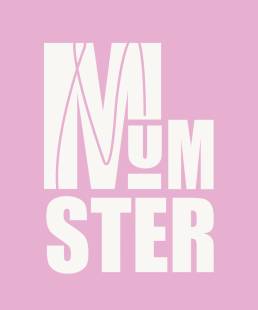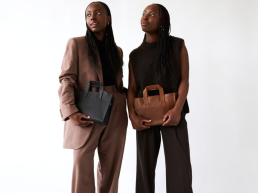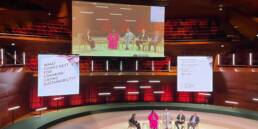It’s almost the end of the month and many of us have been attempting the Veganuary challenge, which consists of trying a vegan diet for the month of January. Whether we’re planning to indefinitely implement a plant-based lifestyle or just exploring vegan alternatives, it’s undeniable that animal agriculture has a huge impact on the planet.
It is in fact estimated that LIVESTOCK FARMING ACCOUNTS FOR AROUND 14.5% OF OUR GLOBAL GREENHOUSE GAS EMISSIONS! Changing our diet can seem daunting, but there are other areas of our lives where we can adopt a cruelty-free approach, fashion is a great place to start! For both brand owners and consumers, in this article we’ll explore the impacts of commonly used animal fibres and their alternatives, so you can make better choices when choosing what to purchase for yourself or to manufacture your garments, let’s dive in!
The use of animal-based fibres is widespread in the fashion industry, with materials such as wool and leather commonly used to produce garments. It can be argued that animal-based materials are more natural and therefore eco-friendly compared to synthetic materials, but it’s not so black or white.
When looking purely at the greenhouse gas emissions of animal-based materials compared to their vegan alternatives, the emissions seem to be much higher when it comes to materials such as leather. “The available lifecycle assessments (LCAs) do show that leather from cattle has higher GHG emissions than, say, polyester or cotton production,” according to Ashley Gill, senior director of standards and stakeholder engagement at materials non-profit Textile Exchange. “Some of those emissions come from the methane from cows’ digestion, emissions from food production, and deforestation happening in the leather supply chain.”
As well as the carbon emission aspect, the use of animal-derived fibres is often linked to cruel exploitative practices of the animals and the destruction of their habitats. Inhumane practices are common with many farms being found to keep animals in inhumane conditions and subjected them to cruel, unethical treatments.
Leather for example comes with a host of issues which are powerfully illustrated in the documentary SLAY. In terms of environmental impact, leather is linked to deforestation as a report by Greenpeace showed, with cattle ranching occupying about 80% of all deforested land in the Amazon region. Leather is also often dyed with harmful substances, such as chrome, that pollute the environment as they’re released through tanneries’ wastewater. From an ethical perspective, it’s also worth noting that the animals used for leather are often kept in poor conditions on large farms that contribute to global warming through their vast contribution of methane. Cattle farming is also water-intensive and often linked to workers exploitation and human rights abuses.
Wool is also associated with significant impacts on animals and the environment. Similarly to leather, wool is also linked to deforestation and soil degradation as a large amount of land is cleared to raise sheep. Wool production is also linked to cruel standard practices such as castration, tail docking, and mulesing. Furthermore, Collective Fashion Justice found that the production of a wool knit jumper emits 27 times more greenhouse gas emissions than a cotton one.
As with all sustainability considerations, impacts can vary and different factors should be taken into account. It is worth noting that animal fibres tend to last longer. A 2018 study that compared the impact of four sweaters – made from wool, cotton, polycotton and acrylic – found that the wool sweater had the least impact when taking into account the use phase.
Vegan alternatives are also often made of synthetics – which come with a host of issues starting with the fact that they’re derived from fossil fuels and are linked to the issue of microplastics being released into waterways when washed.
Whether you’re sticking with animal-based materials or opting for vegan fibres, there are ways to minimise your impacts by choosing conscious brands and opting for certified materials. The Leather Working Group (LWG) for example is a non-profit that’s committed to building a sustainable future with responsible leather, through auditing standards they aim to continually raise the bar for best practices in the industry.
As a social enterprise and BCorp certified company, MYoMY is continuously working to adopt sustainable practices for people, the planet and animals. If you’re not a fan of leather, there are many sustainable alternatives to this material. We are proud to be working with Lisa Marin, a high-end vegan bag brand that aims to eliminate the use of animals in fashion. She marries luxury and sustainability by using Appleskin to manufacture her products.
Shop like you give a damn is another store that strives to be vegan, fair and as sustainable as possible. With a vast offering of brands, including fashion, beauty and homeware, they invite everyone to shop with compassion.
We can’t talk about vegan fashion without mentioning linen, a strong, biodegradable material that’s versatile and long-lasting. Positive fibres recently launched the world’s first 100% compostable blazer made from high-quality linen. This blazer is a one-of-a-kind piece that’s comfortable and breathable so that you can be stylish and sustainable! In partnership with positive fibres, we created a campaign video which reached over 20k views on youtube, watch it here!
Join the fight against plastics in fashion by supporting the Plastic Soup Foundation and brands like Positive Fibers, let’s join forces to change the system! Watch the campaign video we created in partnership with Positive Fibers that dives into their revolutionary Bio-circular™ blazer!
Not only is our blazer eco-friendly, but it is also durable and comfortable to wear. The linen fabric is breathable and perfect for any occasion, whether you’re dressing up for a formal event or going for a casual look.
As much as we support vegan fashion, we don’t think animal fibres should be completely eliminated. Wool for example is a comfortable, insulating and breathable material that’s good for every season, just make sure it’s sourced ethically! We are big fans of UNSALTED, a fashion brand that makes high-quality garments using mulesing-free wool, sourced from an Italian small business that specialises in high-quality yarns.
Another fashion pioneer we admire is THE KNITWIT STABLE, which embraced transparency and traceability by keeping the entire production in one place. From breeding their own goats and sheep to creating yarns and knitting the fibres, they made their entire supply chain visible.
In conclusion, both vegan and animal fibres have their own downsides, but there are options for everyone, no matter what materials you prefer! You can opt for recycled materials or secondhand garments, or perhaps you prefer to try innovative materials, if not maybe you want to stick with the classics and choose certified leather or wool products that are kinder to the planet and animals.
There is no one size fits all, so choose what feels right to you and whilst doing so, opt for small businesses and fashion changemakers that are pioneering sustainable fashion initiatives! If you’re a brand and need guidance on choosing the right fibres for your garments, Common Objective has an array of resources to support you in choosing the best fabric, with practical information, tools and guides on the materials used in fashion, you can be sure to find all that you need to know!
Related Posts
December 18, 2023
The True Impact of Vegan Handbags: How Lisa Marin’s life cycle analysis proves their products are better for the planet than (faux) leather alternatives.
Handbags are one of the most prominent…
September 1, 2023
A Tool for Change: Unveiling the Visionaries of Sustainable Fashion
In a world dominated by fast fashion…
August 16, 2023
Driving Change in the Fashion Industry: Lessons from the Copenhagen Global Fashion Summit 2023
The fashion industry has long been…




